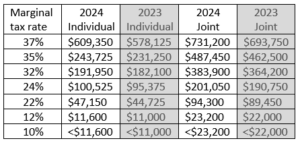We’re about to tell you everything you need to know about filing your 2024 taxes. We want you to absorb it all, take it to heart, act on it, then promptly forget it because 2025 could be completely different with tax changes.

This is the part you need to read
Here are the items that are most likely to affect you as you file your next 1040, according to our reading of Internal Revenue Service guidance:
Standard deduction: The standard deduction for married couples filing jointly is rising $1,500 to $29,200. For single taxpayers and married individuals filing separately, the standard deduction is increasing $750 to $14,600. Heads of households can take a $21,900 standard deduction, or $1,100 more than in 2023. Married seniors over age 65 can deduct an additional $1,550 for each spouse; other singles can deduct an additional $1,950. If you’re a senior and meet the IRS’s definition of blind, that’s another $1,550 each or $1,950 you can take.
Marginal rates: For tax year 2024, the top tax rate remains 37% for individual single taxpayers with adjusted gross incomes – AGIs – greater than $609,350, or $731,200 for married couples filing jointly.
Here’s the whole table with this year’s and last year’s rates:

Alternative Minimum Tax: The AMT exemption amount is $85,700 and begins to phase out at $609,350 for individuals, or at $133,300 for married couples filing jointly for whom the exemption begins to phase out at $1,218,700. Last year’s exemption amount was $81,300 and began to phase out at $578,150 ($126,500 for married couples filing jointly for whom the exemption began to phase out at $1,156,300).
Earned Income Tax Credit: The Maximum EITC is $7,830 for qualifying taxpayers who have three or more children, an increase from $7,430 for last year.
Individual Retirement Accounts: While IRA contribution limit amounts remain the same, phaseout levels for taking deductions for these contributions will increase. If you’re enrolled in a 401(k), phaseout for making IRA contributions will occur at AGIs between $77,000 and $87,000 for individual filers, or $123,000 and $143,000 for joint filers. If you don’t have a 401(k) but your joint-filing spouse does, the phaseout will now range from $230,000 to $240,000. Phaseouts don’t apply if neither of you participates in a 401(k).
A few words of explanation are in order. First, the standard deduction isn’t the maximum you can deduct – it’s just the amount you enter if you don’t want to go through the exercise of itemizing every allowable expense, or if you feel like your itemized deductions won’t reach the standard deduction threshold. There is, in fact, no upward limit on how much you can deduct if you show your math.
Second, a marginal tax rate of 35% doesn’t mean you’re paying 35% of your adjusted gross income in taxes. It’s a stairstep function. A single person pays 10% on the first $11,600, 12% on the next $35,549 (the $47,149 ceiling of the next bracket less the $11,600 ceiling on the bottom bracket) and so on. That top-bracket single earner will only pay the top rate for what you make in excess of $609,349.

If you file as “head of household” rather than as an individual or married couple, the 2024 tax bracket changes are much the same as for individuals. There is, however, some tax shielding for the first $47,149 so, if you’re single with a dependent, head of household might be the way to go.
And if you want to know more about what the IRS means by AGI, read the column below.
These 2024 tax bracket changes might apply to you too
We’d be remiss not to include a few other bullet items:
- The monthly limit for the qualified transportation fringe benefit and the monthly limitation for qualified parking increases from $300 to $315.
- The dollar limitation for employee salary reductions for contributions to health flexible spending arrangements increases to $3,200. For cafeteria plans that permit the carryover of unused amounts, the maximum carryover amount is $640, an increase of $30 from 2023.
- Medicare Advantage participants with Medical Savings Accounts who have self-only coverage must have an annual deductible that is not less than $2,800, but not more than $4,150, with $5,550 in maximum out-of-pocket expense. For family coverage, the annual deductible is not less than $5,550, but the deductible can’t be more than $8,350, and the out-of-pocket expense limit is $10,200. All these figures have small increases over last year baked in.
- For tax year 2024, the foreign earned income exclusion is $126,500, compared with $120,000 for tax year 2023.
- The estate tax, or “death tax” if you prefer, kicks in at $13,610,000 per person, up from $12,920,000 last year. Below that, your heirs get every dime.
- The annual exclusion for gifts increases from $17,000 to $18,000.
- The maximum credit allowed for adoptions increased from $15,950 to $16,810.

Crystal ball time
A lot of these formulas come out of the Tax Cuts and Jobs Act, the 2017 law which was the signature achievement of Donald Trump’s first term. And, like any sensible legislation, it has a sunset date at which it needs to be renewed, retooled or retired. That date is December 31 of this year.
The good news is, the party that crafted and passed the bill is back in charge of both houses of Congress, so odds are the TCJA will likely pass again in some form. But let’s not get ahead of ourselves. No Democrat in either chamber voted for the bill the first time around. Their votes weren’t needed, though. Things might be different this time because, in 2017, 13 GOP members of Congress voted against the TCJA and it still passed. This time around, House Republicans outnumber Democrats by only four seats, so anything can happen. Bipartisanship, and the compromises that entails, might be the only way to get a renewed TCJA across the goal line.
Expect members on both sides to lose their inside voices over not only the size of the standard deduction but also itemized deductions for state and local tax deductions as well as mortgage interest and small-business income. The 2024 tax rates – and even the existence – of bracket changes make for a perennial shouting match, and it only gets louder once someone mentions the AMT. Such think tanks as the Brookings Institution and the Bipartisan Policy Center have excellent recaps on the issues involved in reenacting the current law.
So, the 1040 you file next year will probably look like the one you filed this year and last year. After that, though, who knows what tax changes 2025 will bring? Our Smith Anglin advisors and tax professionals are paying close attention to these changes making us a quality team to work with. Reach out to us to learn more about how we serve our clients with our comprehensive wealth management services.




